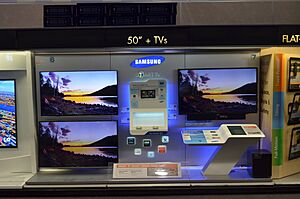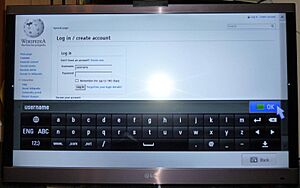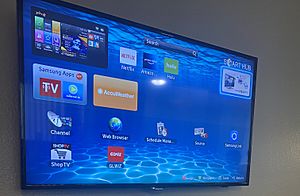Smart TV facts for kids
A smart TV is like a regular television set that also has Internet built right in! Think of it as a mix between a TV, a computer, and a digital media player. It lets you do more than just watch regular TV channels.
With a smart TV, you can watch videos and movies online, listen to music, and even look at photos. You can also browse the internet, just like on a computer or smartphone. These TVs can connect to your home network to share content.
Smart TVs are different from just watching TV over the internet. A smart TV has its own special operating system (like the software that runs your phone). This system lets you use different apps. You can find these apps in an application store, just like on a smartphone.
The technology that makes a TV "smart" can also be found in other devices. These include set-top boxes, Blu-ray players, game consoles, and even some digital media players. These devices help you find and play content from the internet or your own storage.
Contents
What is a Smart TV?
A smart TV is a television that has internet features built-in. It's much more powerful than a basic TV. You can think of it as a computer system combined with a TV screen.
Smart TVs use an operating system, just like your phone or computer. This system lets you install and use many different apps. These apps can do all sorts of things.
Many smart TV systems have an app store. This is where you can download new apps. Developers can create apps that work on many different smart TV brands. This makes it easy for you to find your favorite apps.
Smart TVs can also show content from other devices in your home. This includes photos, movies, and music from your computer or storage devices. They also connect to online services like Netflix, Hulu, Spotify, and YouTube. You can watch movies, shows, play games, and use social media apps.
How Smart TVs Started
The idea of "smart" TVs began a long time ago. In the 1980s, some TVs in Japan could show extra information. This was like an early form of connecting TVs to data.
Later, in the 1990s, people started thinking about TVs that could connect to networks. They imagined TVs that could download software and do more than just show TV channels.
In the early 2000s, some companies tried to make "Internet TVs." These TVs let people go online. However, these early versions were not very popular.
Smart TVs really took off in the late 2000s and early 2010s. This was when digital television became very common. By the late 2010s, smart TVs became the most popular type of television. Many TV makers now focus on making smart TVs.
Cool Things Smart TVs Can Do
Smart TVs let you watch videos from sites like YouTube. You can also see your own photos and videos. These can be stored on a hard drive or in cloud storage online.
Smart TVs make it easy to find and watch your favorite shows. They can even remind you about upcoming programs. Some smart TVs have special ways to control them.
You might use gestures (like waving your hand) or even your voice to control the TV. Some TVs can connect to your smartphone or tablet as a "second screen" remote. This makes it easier to find what you want to watch.
New features are always being added to smart TVs. For example, some TVs let you buy apps, movies, or games right from your TV. You can use your remote or even your phone to do this.
Smart TV Systems and Brands
Smart TVs use different software systems, called platforms. These platforms are like the operating system on your phone. They let you run apps and access online content.
Some popular smart TV platforms include Android TV, Google TV, and Roku. Many big companies make smart TVs using these or their own platforms.
Some of the well-known brands that make smart TVs are Samsung, LG, Sony, Panasonic, and TCL. Each brand might have its own special features and app store.
How Popular Are Smart TVs?
Smart TVs have become very popular around the world. In 2012, many homes had a smart TV, but not all were connected to the internet. By 2019, over a billion smart TVs were in use globally.
Many people use smart TVs to watch online streaming services. Services like Netflix, Amazon Prime, and Hulu are very common. This shows how much people enjoy watching content over the internet on their TVs.
Using Your Smart TV Safely
Connecting with Friends
Some smart TV platforms come with social networking features. This means you can connect with friends while watching TV. It can make watching shows a more interactive experience.
Ads on Smart TVs
Just like on websites or apps, smart TVs can show you ads. These ads might be chosen based on what you watch. Companies use this to show you things they think you might like.
It's important to know that smart TVs can collect some information about what you watch. This helps advertisers show relevant ads. Always check your TV's privacy settings to understand what information is shared.
Keeping Your Smart TV Safe
Like any device connected to the internet, smart TVs need to be kept safe. Sometimes, there can be security issues. It's important to keep your TV's software updated. Updates help fix any weaknesses and keep your TV secure.
Always be careful about what information you share online. Make sure to use strong passwords for your accounts. If your TV has a camera or microphone, be aware of its settings. You can often turn these off if you don't use them.
Some companies are working on special antivirus software for smart TVs. This helps protect them from harmful programs. Being smart about your TV's settings helps keep your information private.
Content You Can Access
Sometimes, certain websites or apps might not work on every smart TV. This means some content might not be available on all platforms. Companies decide which services work with which TVs.
Keeping Apps Updated
Sometimes, after a software update, a smart TV might have temporary issues. Also, apps on older smart TVs might not always get the newest updates. This means some new features might not work on older models.
See also
- 10-foot user interface
- Automatic content recognition
- Digital Living Network Alliance (DLNA)
- Digital media player
- Home automation
- Home theater PC
- Hotel television systems
- Hybrid Broadcast Broadband TV
- Interactive television
- Internet of things
- List of mobile app distribution platforms
- List of smart TV platforms
- Over-the-top media service (OTT)
- PC-on-a-stick
- Second screen
- Smartphone
- Space shifting
- Smart speaker
- Telescreen
- Tivoization
- TV Genius
- Video on demand




